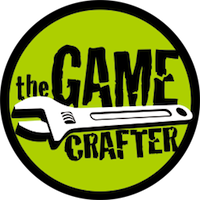


Hello-6
Requirements
Description
Hello-6 is the first in a new series of complex and brief board games I have designed. Hello-6 is the "easiest" one in this series. The game consists of rolling a pair of dice and placing them on the board. You can optionally make up to two adjustments to the dice each turn. An adjustment is an increment, a decrement, or a slide like a chess queen to a vacant square. There are no captures in this game. But, that isn't the object of this game anyway. We will discuss the object of the game in short order.
Next, we have what we call buttons in this game. Each player gets 7 HL buttons and 7 EO buttons. The HL stands for High-Low, and the EO stands for Even-Odd. These buttons get placed two per turn starting on the third turn. The idea is you want to maximize your own score while minimizing your opponent's score. On each file, rank, and long diagonal, there are two circles that connect to it from opposite sides of the board. The players place their buttons on these circles in the H, E, L, or O positions. Incidentally, that's how this game got its name from the letters on the buttons formed into the word Hello (High Even Low Low Odd).
When the board is full after Black's ninth turn, the players do a reckoning. This means looking at each of the 28 buttons and scoring them. If a button gets 4 right in its file, rank, or diagonal, it earns one point for the player. If 5 are correct for the button, then that earns two points for the player. And, if all 6 are correct for the button, then that earns three points for the player. It is up to the opponent to bring your score down!! If you have an H button on a file, let's say, and your opponent has two dice on that file, we would expect the opponent to decrement his dice to being low dice (1, 2, or 3). Your own dice on this file, you would endeavor to increment to high dice to try to maximize your score for this button. Where the complexity comes in, though, is that your opponent may be looking at his dice on this file in terms of how they help him from the perspective of the ranks that these dice belong to. So, all of the files, ranks, and diagonals need to be looked at to get the placement of your buttons to be as good as they can be. Your opponent is endeavoring to do the same thing, and this is where the struggle of this game takes place. Who can maximize their score while minimizing their opponent's score better? On any turn after the third turn, you place two buttons as desired on vacant circles. You have the option of making up to two adjustments in the circle area, too. An adjustment in this area is a flip over or a slide in either direction to another vacant circle. Note that slides in either the circle area or the square area must be along a path of vacant spaces (i.e. always slide on a clear path). Thus, as the game progresses, sliding becomes more difficult, and then increments, decrements, and flips become the primary adjustments. There is a PDF file available for free download on this shop page. Please print it out for a complete explanation of the rules, which also includes extra information for scoring rated games.
Components
| Component | Quantity | Photo |
|---|---|---|
| Large Stout Box (Only Top Printed) | 1 |  |
| Large Square Mat Set | 1 set of 1 large square mats |  |
| Small Circle Chit Set | 1 set of 28 small circle chits |  |
| D6, 16mm, Black | 18 |  |
| D6, 16mm, Rounded, Ivory | 18 |  |
Vitals
| Average Rating | 0 reviews |
|---|---|
| Publish Date | August 01, 2020 |
| Edition | First |
| Department | Games |
| More Info | Hello-6 web site |
Why buy this?
- The game is always finished in nine turns.
- About ten quintillion times the unique positions in chess.
- Randomness and pure skill are blended well in this game.
Tony Berard
Notes
- This game contains a premium upgrade called UV Coating that makes the printed components more durable.
- This game contains laser cut components. Laser cut items will have a slight amount of soot around the edges, which can easily be wiped off; and will have a campfire smell for about a week after you open them.
